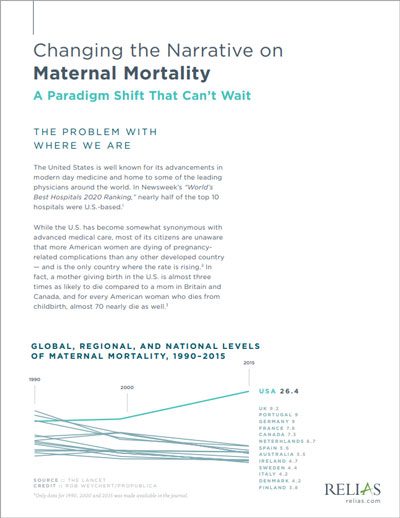The United States is well known for its advancements in modern day medicine and home to some of the leading physicians around the world. While the U.S. has become somewhat synonymous with advanced medical care, most of its citizens are unaware that more American women are dying of pregnancy-related complications than any other developed country — and is the only country where the rate is rising. Recent data shows:
- The U.S. maternal mortality rate remains stubbornly high, at 17.4 deaths per 100,000 live births, totaling 658 deaths in 2018.
- Pregnancy-related mortality for American Indian, Alaska Native, and Black women is two and three times higher, respectively, than for white, Hispanic, and Asian/Pacific Islander women.
- Women over 35 years are 1.5x more likely to experience complications during pregnancy.
However, the data also tells us that:
- Nearly 66% of all pregnancy-related deaths are preventable.
- Implementing evidence-based measures to reduce maternal mortality has been shown to cut mortality by as much as half.
New National Action on Maternal Health
To address our nation’s maternal mortality crisis, the Department of Health and Human Services (HHS) last month announced its vision for ensuring the U.S. is one of the safest countries in the world to give birth in the Healthy Women, Health Pregnancies, Healthy Futures: Action Plan to Improve Maternal Health in America. The plan outlines four specific goals with examples of direct actions the HHS will take to advance rapid improvement:
- Healthy outcomes for all women of reproductive age.
- Healthy pregnancies and births.
- Healthy futures.
- Improve data and bolster research.
Specifically, the Action Plan aims to achieve three targets — noted as being ambitious, yet attainable:
- Reduce the maternal mortality rate by 50% in five years.
- Reduce the low-risk cesarean deliveries by 25% in five years.
- Achieve blood pressure control in 80% of women of reproductive age with hypertension in five years.
Maternal Mortality Challenges
We have struggled with a maternal mortality crisis for more than three decades, largely in part due to the incredible challenges associated with such widespread improvement. The new HHS Action Plan to Improve Maternal Health in America calls out these challenges and considers their role in a life course perspective to improving maternal and infant health outcomes. The identified challenges include:
- Racial disparities.
- Access to care, especially in rural areas.
- Health insurance coverage.
- Variation in clinical practice patterns.
- Data quality and timeline to inform efforts to improve care.
Maternal Health Questions for Stakeholders
As a healthcare professional who has focused on largescale maternal safety efforts for nearly 15 years, the new HHS Action Plan gives me hope. For over 30 years, our nation’s mothers have been at risk in a country where they certainly deserve better. The time to act is now, and for healthcare leaders reevaluating their approach to maternal health improvement, I offer these questions for consideration:
- What is my role in improving maternal care?
- What can I learn from my colleagues and peers who have pushed the needle forward on maternal safety efforts?
- What data is missing from my organization’s maternal and perinatal care?
- How well do I understand (or contribute to) the variation in care for moms and babies?
- What are the greatest risks to mothers delivering within my organization?
Our mothers and babies deserve better, and yes — it is very possible. The best practices have been proven, and I’ve witnessed hospitals and health systems achieve significant improvement in maternal safety, affecting thousands of women and their precious babies.
And while we have made progress, I see firsthand how much further we must go. The maternal mortality crisis hasn’t changed nearly enough over the last 30 years, but the HHS Action Plan to Improve Maternal Health in America is progress. It shows that our nation, at the highest level, is treating this issue with the attention and urgency it warrants.
There is a lot to unravel in the HHS Action Plan. To start, it outlines a $24M budget provided for the CDC to expand Maternal Mortality Review Committees (MMRCs) to all 50 states to ensure every pregnancy-related death is examined. This funding will enable MMRCs to perform detailed examinations of individual maternal deaths to identify potential mitigation strategies that can be implemented to avoid deaths from occurring in the future for women with similar circumstances.
Securing an MMRC for every state will provide meaningful data that has been proven to advance maternal safety efforts in states already benefiting from such committees such as California.
How Relias Can Help
For more than 20 years, Relias has helped hospitals identify and reduce variation in care and improve patient safety with analytics, provider and nurse assessments, and evidence-based education tailored to the individual.
Relias OB offers a suite of AWHONN-validated and co-authored courses for providers and nurses on promoting vaginal birth (reducing low-risk cesarean deliveries), hypertension in pregnancy, managing shoulder dystocia, obstetrical and postpartum hemorrhage, and fetal heart rate and uterine contraction monitoring.

Changing the Narrative on Maternal Mortality: A Paradigm Shift That Can't Wait
The U.S. is faced with an urgent call to improve maternal care. This white paper outlines where we are as a nation, where we need to go in terms of improvement, and how to get there.
DOWNLOAD WHITE PAPER →





